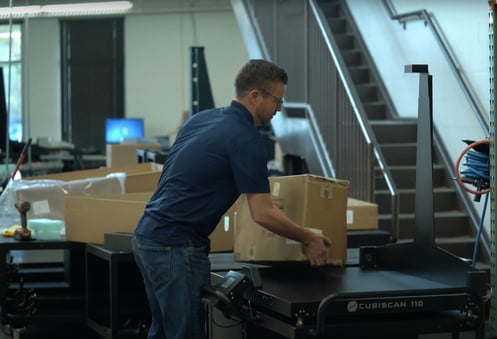Many industries are experiencing a shortage in labor. Warehouses and distribution centers are among those that are having trouble finding and keeping employees. Due to the COVID-19 pandemic, 2020 saw record breaking amounts of packages shipped all over the world. This momentum has continued into 2021. Despite the massive number of packages shipping out, warehouses and distribution centers are experiencing a labor shortage. This puts them in a unique position. They have work to do, but not enough people to do it. Luckily, dimensioning systems can help alleviate some of the burden caused by labor shortages by automating processes and/or making existing employees more productive and efficient.
 MAKE CURRENT EMPLOYEES MORE EFFICIENT
MAKE CURRENT EMPLOYEES MORE EFFICIENT
Some dimensioning systems can make overworked and spread-thin employees more efficient. With dimensioning systems like the Cubiscan 25 or 325, a single employee can collect the dimensions of any item in a matter of seconds. Simply place the item on the scale, move the sensor over it, and within 2-3 seconds you have highly accurate dimensions. Using tape measures and other means of collecting measurements is time consuming and often inaccurate. In the time it takes for an employee to use a tape measure to collect the measurements of an item, another employee using a dimensioning system has already done five or more.
Other dimensioning systems can attach to an already existing conveyor belt. These dimensioners collect dimensional data on items as they pass under measurement sensors. If an operation is dealing with a labor shortage, an automated system such as the Cubiscan 275, or Cubiscan 210-DS can do the work of several employees using outdated tools to collect dimensions.
REDUCE EMPLOYEE CHURN
It’s no secret that manual warehouse labor can be hard. Long and odd hours, heavy boxes that need moving, forklifts coming around every corner, and monotonous work describe typical warehouse environments. With dimensioning systems, employees can do better work with less physical exertion. Companies can’t survive without employees so it’s important to make their jobs less strenuous. Retaining employees is a great way to save money. According to a study by Glassdoor, replacing a single employee can cost around $4000 after advertising, background checks, and paid training. In labor positions, it’s possible to fill the exact same position on multiple occasions in a single year. With dimensioning systems, employee longevity goes up along with the company’s yearly savings.
GRACEFULLY HANDLE SPIKES IN VOLUME
From October to early December, massive amounts of items are ordered online. These orders need to be distributed and transported to the customer. This puts additional pressure on shippers and distributers to perform and continue to deliver a great customer experience. With dimensioning systems, shippers and distributers can rest easy knowing they have the technology in place to handle high volumes of orders efficiently, accurately, and reliably even if they aren't fully staffed.
CONCLUSION
For a long time, the answer to labor shortages has been to hire more. However, the hiring process takes time and costs money. It takes time to interview, hire, and finally train candidates. During that time, business doesn't stop and it will take some time for new hires to be proficient. Sometimes, an operation won't have the necessary resources to hire more. With dimensioning systems, companies can give a valuable tool to existing employees to increase their daily output or do the work of multiple employees depending on the type of system and the needs of the operation.
If your warehousing operation is dealing with a labor shortage, the Cubiscan team is ready to help. Click the button below, send an email to info@cubiscan.com, or call us directly at (801) 451-7000 to find out what dimensioning system is best for you.

 MAKE CURRENT EMPLOYEES MORE EFFICIENT
MAKE CURRENT EMPLOYEES MORE EFFICIENT
